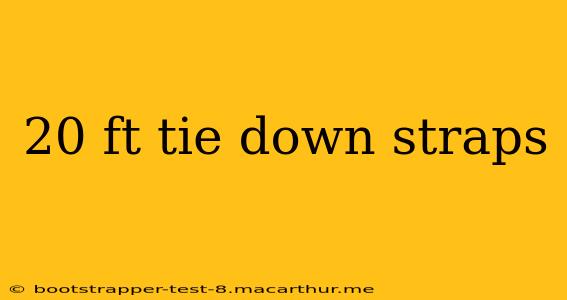Securing cargo safely and effectively is paramount for transportation. Whether you're hauling equipment, materials, or recreational vehicles, choosing the right tie-down straps is crucial. This guide focuses on 20ft tie-down straps, exploring their uses, choosing the right type, and ensuring safe and compliant practices.
What are 20ft Tie Down Straps Used For?
20ft tie-down straps offer significant reach, making them ideal for securing larger or longer items. Their length allows for effective restraint even with extended load dimensions. Common applications include:
- Hauling boats: Securing boats on trailers requires robust straps with sufficient length to manage the boat's dimensions and prevent movement.
- Transporting construction materials: Long lengths of lumber, pipes, or other materials often necessitate longer straps for secure fastening.
- Moving oversized furniture: From sofas and sectionals to pianos and other large items, these straps provide the needed length for secure movement.
- Securing cargo in trailers and trucks: Any situation where a long item needs to be secured effectively can benefit from the extra length.
- Industrial applications: Manufacturing, warehousing, and other industries rely on tie-down straps for secure storage and transportation of various goods.
What to Consider When Choosing 20ft Tie Down Straps
Several factors should guide your selection of 20ft tie-down straps:
- Working Load Limit (WLL): This is the maximum weight a strap can safely handle. Always choose a strap with a WLL significantly exceeding the weight of your cargo. Underestimating this can lead to dangerous situations.
- Breaking Strength: This indicates the maximum force before the strap breaks. It's typically several times higher than the WLL, providing a safety margin.
- Strap Material: Popular materials include polyester and nylon, each offering different strengths and properties. Polyester is often preferred for its strength and resistance to stretching.
- Ratchet Type: Ratchet mechanisms vary in quality and ease of use. Ensure the ratchet is durable and provides a secure clamping action.
- End Fittings: Secure and sturdy end fittings are crucial. Look for heavy-duty hooks, D-rings, or other fittings appropriate for your application.
What is the best material for 20ft tie down straps?
Polyester and nylon are the most common materials for tie-down straps. Polyester is generally stronger and less prone to stretching than nylon, making it a popular choice for heavy-duty applications. However, nylon can offer better resistance to certain chemicals. The best material depends on the specific use and the type of cargo being secured.
How many 20ft tie down straps do I need?
The number of 20ft tie-down straps needed depends entirely on the size, weight, and shape of the cargo. Larger, heavier, or irregularly shaped items will require more straps for adequate security. Always consult your vehicle's owner's manual and relevant safety guidelines for recommendations. It is better to over-secure than under-secure.
How to use 20ft tie down straps safely?
Safe use of tie-down straps involves proper techniques to prevent damage to your cargo and avoid accidents.
- Properly secure the cargo: Ensure the cargo is evenly distributed and stable before attaching straps.
- Use the correct WLL: Never exceed the Working Load Limit (WLL) of your straps.
- Attach straps securely: Use appropriate anchor points on your vehicle or trailer, ensuring they are strong enough to withstand the load.
- Maintain tension: Ensure the straps are tightly fastened, but avoid over-tightening.
- Regularly inspect straps: Regularly check for wear, tear, or damage. Replace damaged straps immediately.
Maintaining and Replacing Your 20ft Tie Down Straps
Regular maintenance of your straps is critical for safety.
- Inspect for damage: Look for fraying, cuts, or other signs of wear.
- Check the stitching: Ensure the stitching remains intact.
- Test the ratchet: Make sure the ratchet mechanism works smoothly and securely.
- Replace damaged straps: Never use damaged straps. Replace any worn or damaged straps immediately.
By understanding the features of 20ft tie-down straps and following safe handling practices, you can ensure the secure and reliable transportation of your cargo. Remember, safety should always be the top priority.
